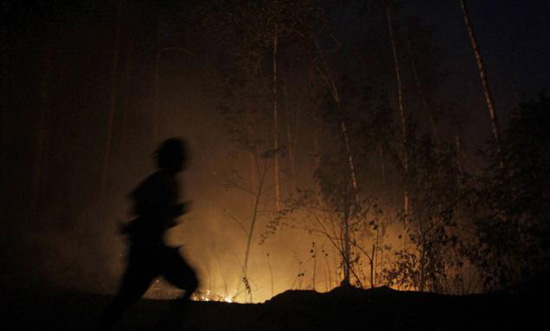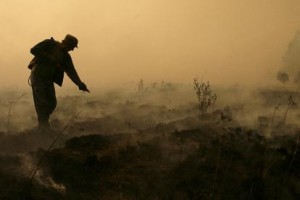Why Russia Is Burning
Yes, it’s the hottest summer on record, but there’s more to it.

Moscow has been choking through an unrelenting pea-soup smog. Smoldering under record heat, the peat bogs in the land that surrounds the city have been catching fire.
Peat is a kind of decomposed, compacted, vegetation, with lots of carbon. Before coal and oil took over, people used to dig up blocks of peat, dry it out, and then burn it for fuel. Dry peat is highly combustible.
If it’s not dried out though, it won’t burn. So why are the once-marshy Russian peat bogs burning?
Because they were deliberately drained.
How the peat bogs dried out
It started about 100 years ago when Russian engineers drained the bogs and marshes to dry out the peat and burn it in power stations to produce electricity. They continued draining the bogs and drying out the peat for another 40 years until natural gas was discovered in Siberia in the late 1950s.
 But the bogs were never re-flooded. They’re bone dry, and highly flammable.
But the bogs were never re-flooded. They’re bone dry, and highly flammable.
Worse, you can’t put out a peat fire like you can a forest fire – by simply dropping lots of water on it. The peat fires spread underground, with lots of air pockets (again caused by the drying out). So, it’s virtually impossible to get the whole thing. You soak one area, but deep underground, the smoldering core is reaching out through the peat network until it suddenly explodes somewhere else. It’s like chasing an invisible enemy.
In one area of the fire, it was reported that firefighters had pumped water from a nearby lake at the rate of a 100 gallons of water a minute, around the clock, to reach all the arteries of what was happening underground. All that remained, apparently, was a muddy swamp with charred stumps of trees.
So, was the fire out? No. It was still burning underground, spewing smoke through surface vents.
Massively more smoke than a forest fire
Peat fires can burn up to 10 times more material in any given area than an above-ground forest-type fire. They produce massively more smoke, heavy smoke that, because it’s cooler than in a forest fire, stays close to the ground rather than being drawn up into the sky. So, far more of it reaches into homes and other buildings, creating more health problems for humans and other animals.
Moscow is particularly vulnerable to peat fires. The nearby city of Elektrogorsk (Electrical City) was built in 1912, 50 miles from Moscow, to house the new peat-fired power plants. Today, several of the fires are burning in the dried-out bogs around Elektrogorsk.
Burning up the crops
Latest news (August 15th) is that the fires have destroyed 25 percent of the Russian grain crop, and that grain exports have been halted … which will have repercussions in poor countries around the world.
